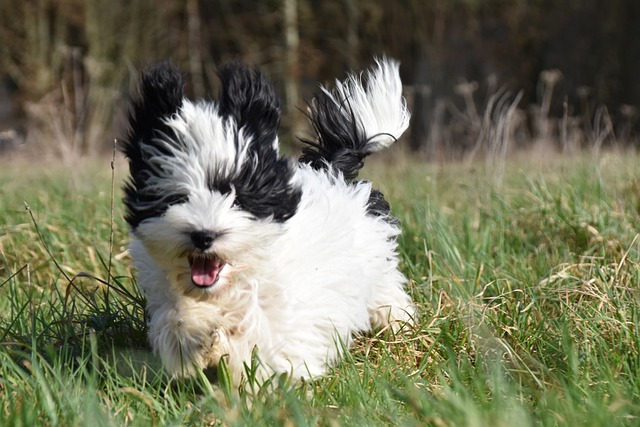Havanese shed, contrary to popular belief (and what money-hungry breeders would have you believe). Compared to other breeds, however, the Havanese is a light shedder.
The Havanese Shed
The Havanese breed does shed, but they shed lightly.
Additionally, this breed tends only to shed noticeably in the spring and fall when the seasons (and outdoor temperatures) change.
About The Havanese
The Havanese is a Cuban dog bred in the eighteen-hundreds for companionship.
The Havanese is an affectionate dog frequently marketed as a hypoallergenic and non-shedding breed, even though this is untrue.
The Havanese Coat
The Havanese has a double-layered coat that is medium length. At birth, the Havanese coat is short, and as it grows, it becomes fluffy.
By the time a Havanese puppy is fifteen months old, an adult coat replaces its puppy coat.
As the adult coat grows in, the Havanese can seem quite “messy” as they struggle with two coat textures and various length coats.
Meanwhile, the undercoat continues to develop. Both the adult coat and the undercoat are soft to the touch. Some Havanese dogs can take up to four years to grow into adult coats.
Genetics and grooming play a role in the length, fullness, and texture of the adult coat, which is often quite silky to the touch.
While the adult Havanese coat does shed, it sheds minimally compared to other breeds like the German Shepherd and Husky.
Grooming and Shedding
Keeping the Havanese coat in peak condition requires daily brushing to prevent matting.
Regular brushing also stimulates oil glands that keep skin moisturized and protected and the coat nice and shiny.
Daily brushing may seem like a chore, but if you suffer from allergies or are concerned about shedding, brushing goes a long way to help in both situations.
As you brush your dog’s fur, loose hair emerges and adheres to the brush rather than falling to the floor or winding up on your furniture.
Less hair lying around means less exposure to allergens and a cleaner home.
The Havanese also requires grooming every four to five weeks to maintain a healthy coat length and texture.
Keeping the Havanese coat healthy overall plays a significant role in controlling shedding and keeping your Havanese looking well.
Hypoallergenic Vs. Non-Shedding
The Havanese often gets touted hypoallergenic and non-shedding, but what is the difference?
Hypo-allergenic refers to something unlikely to cause an allergic reaction. For example, dye-free, scent-free laundry detergent.
Non-shedding refers to something that does not shed hair.
For example, a “skinny pig” (naked guinea pig) does not shed hair.
Coping With Shedding
You were likely surprised when your pup started to shed if you invested in a Havanese, under the impression that they do not shed at all.
By this time, though, you have already grown attached to the little pup…so what can you do to better cope with shedding?
- Invest in a good-quality robot vacuum designed for homes with animals. Keeping a vacuum running regularly will pick up stray hairs and keep them from building up.
- Keep up with daily brushing and regular grooming appointments to keep your dog’s coat healthy. A healthy skin sheds much less than an unhealthy coat.
- Check with your vet if your dog seems to be shedding more than it should. A skin condition, nutritional deficiency, or other illness could be causing fur loss and needs to be treated ASAP to prevent long-lasting effects on your dog’s health.
- Do not bathe your dog too often; always use dog shampoo. Overbathing dogs can stress the skin and coat, and using human shampoo throws off the pH of your dog’s skin. Both of these things can eventually result in fur loss!
Are Havanese Hypoallergenic?
No. Despite being marketed as hypoallergenic by some breeders, Havanese are not hypoallergenic.
Allergies 101
The body’s immune system works by identifying organisms that threaten the body, for example, bacteria.
When the immune system identifies these harmful organisms, it launches an attack against them to protect itself.
When someone suffers from allergies, their immune system is triggered by non-harmful substances because their immune system is oversensitive.
So, when someone is allergic to dogs, their immune system identifies proteins in a dog’s skin cells, saliva, or urine as dangerous to the body and launches an attack.
This attack is what causes allergy symptoms.
Since the proteins that trigger dog allergies are in urine, dander, and saliva, dogs can’t be hypoallergenic – even if they do not shed a lot!
Studies show that a dog’s saliva has more allergy-triggering proteins than dander!
There is an advantage to having a low-shedder dog when you suffer from allergies, though the less fur your dog sheds, the fewer allergy-triggering substances fall around your home.
So, while the Havanese is not hypoallergenic, it is a much better choice for someone who suffers from allergies than, say, a husky that sheds heavily year-round.
Havanese Shed – Final Thoughts
The Havanese shed, they are not a hypoallergenic breed; although not as much as other dogs.
If you are searching for a dog that doesn’t shed at all, you are looking for a hairless breed.
If you are looking for a hypoallergenic dog, you are out of luck!

